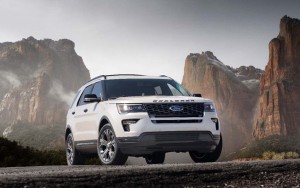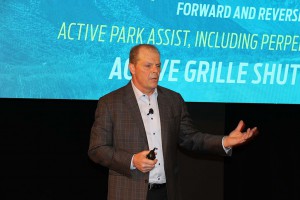Utility vehicles now account for 40% of the American market – and a disproportionate share of its profits – but demand is likely to keep growing and could soon reach 50% before leveling off, said a senior Ford Motor Co. executive ahead of this week’s New York International Auto Show, where a number of new SUVs and CUVs will make their debut.
Utes have become the hottest segment in the industry, in part because carmakers continue to find ways to surprise and delight customers with all manner of new designs and features, said Mark LaNeve, Ford’s head of sales, service and marketing. And where classic SUVs once required owners to “sacrifice” things like fuel economy and on-road comfort, today’s utes are nearly as efficient and comfortable as conventional sedans and coupes.
As a result, “We don’t see (the SUV sales boom) stopping,” said LaNeve, as Ford revealed two new versions of its popular Explorer SUV and announced plans to update the long-neglected Expedition model for the 2018 model-year.
As recently as 2006, utility vehicles – which include classic SUVs, as well as newer crossover-utility models – accounted for just 28% of the American new vehicle market. That hit 40% in 2016, and the upward trend continued during the first quarter of 2017, LaNeve noted.
“Over the next five to seven years, we see it getting to 45%, even higher,” he said at the Manhattan even. “It could reach 50 percent.”
(Click Here to check out the 707 hp Jeep Grand Cherokee Trackhawk.)
Ford sees several target groups driving the SUV boom:
- Millennials often grew up with utility vehicles and, as they grow and start families, it is often their vehicle of choice;
- Baby Boomers are choosing utes for practical purposes, often downsizing from larger sedans to compact SUVs and CUVs.
What helps drive the utility vehicle boom is the flood of new designs and sizes. Today, buyers can choose from anything from subcompact to full-size eight seaters. There are traditional, body-on-frame models, more sporty, car-based crossovers, wagon-like utes and other models that defy easy categorization.
“You get into shades of grey,” said Ford’s sales chief, “about what is an SUV.”
Equally important, automakers have been able to cut mass and introduce new, fuel-saving technologies such as Ford’s turbocharged EcoBoost engines paired with eight, nine, even ten-speed transmissions. The “fuel efficiency gap” between most utes and comparably sized sedans and utes is typically down to just a couple miles a gallon, LaNeve noted.
Meanwhile, car-based crossovers offer much smoother rides, often while still providing some level of off-road capabilities.
And manufacturers are now launching SUVs and CUVs that match the performance and luxury features in conventional passenger cars. At this week’s New York International Auto Show, Mercedes-AMG will roll out the 600-horsepower GLC 63 S, while Fiat Chrysler Automobiles will launch the 707 hp Jeep Grand Cherokee Trackhawk.
(Automakers push out new wave of high-performance SUVs. Click Here for the story.)
For its part, Ford is bringing several new, up-market versions of its Explorer to the Big Apple. That includes the Platinum Edition, loaded with an array of luxury-level features, including the sort of high-tech systems Millennials love: starting with a 4G LTE WiFi hotspot that can be connected to 10 separate devices, as well as an auto part system.
Consumers continue to demand more and more of these features, as well as heated and cooled leather seats, big touchscreen infotainment systems, high-powered audio packages and more. And that has driven up the average transaction price on Ford’s various SUV models by about $4,000 a vehicle “in the last several years,” LaNeve suggested.
“That isn’t from price increases,” he concluded. “It’s customer choosing more well-equipped vehicles.”
(Alfa Romeo reveals more versions of luxurious Stelvio SUV at NY Auto Show. Click Here to check them out.)



